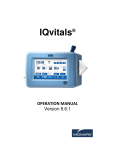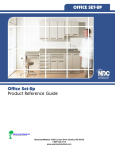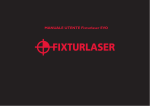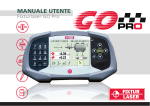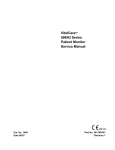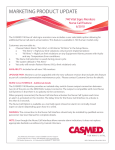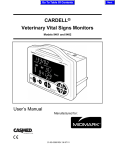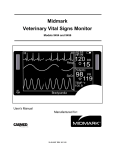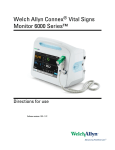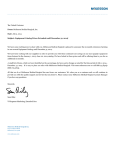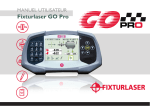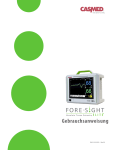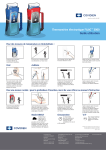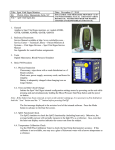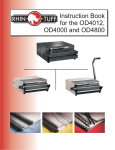Download Model 740 User`s Manual w/WA Plus, English
Transcript
CASMED 740 Monitors 10. CLEANING CLEANING OVERVIEW WARNING: Do not, under any circumstances, perform any testing or maintenance on the monitor while the monitor is being used to monitor a patient. The monitor must be turned “OFF”. Unplug the monitor from the AC power source and remove the internal battery. CAUTION: Do not open the monitor to clean or repair it. Contact CAS Medical System for service needs. CAUTION: Disconnect all accessories from the monitor before cleaning. Do not immerse any part of the electrical connector of the cable or accessories in the cleaning or disinfection solution at any time. Do not use an abrasive cloth or cleaner on the accessories. THE MONITOR On a daily basis, examine the monitor’s case for any damages and check the AC power cord for bent or broken prongs, cracks or fraying. Neither the monitor nor the power cord should be used if damaged. If any damage is noted, contact the appropriate service personnel. CAUTION: Do not spray any water or cleaning solution directly onto the monitor. As needed, clean the monitor using a soft cloth dampened with a mild dishwashing detergent solution and gently rub the soiled area until clean. Use a clean soft cloth to dry the monitor. Do not use abrasive cleaners on the monitor. Do not use either isopropyl alcohol or solvent to clean the monitor. Use of these cleaners can cause damage to the monitors’ surface. Do not immerse the monitor or power cord in the cleaning solution. When necessary, the monitor surfaces may be disinfected using a soft cloth saturated with a 10% (1:10) solution of chlorine bleach in tap water. When all of the surfaces have been disinfected, wipe the entire surface of the monitor using a soft cloth dampened with fresh water to remove any trace amounts of residue and/or fumes. NOTE: Thoroughly wipe off any excess cleaning solutions. Care should be taken to prevent water or cleaning solution to run into connector openings or crevices. 21-02-0298 REV. 02 02/09 135 CASMED 740 Monitors THE DISPLAY CAUTION: Use care when cleaning the display. Scratches may occur. Occasionally, as needed, clean the display window using a soft, lint-free cloth sprayed with an alcohol free glass cleaner. Do not use either isopropyl alcohol or solvent to clean the display. Use of these cleaners can cause damage to the display. The use of paper towels is not recommended as it may scratch the surface. CUFFS NOTE: Refer to the product packaging for additional Cleaning and Disinfecting Instructions were applicable. Prior to each patient use, inspect the blood pressure cuff and its hose for damage. CAUTION: If the cuff should become grossly contaminated with blood or other bodily fluids, it should be discarded. NOTE: CASMED does not recommend submersion of the cuff. Liquid should not be permitted to enter the cuff bladder because instrument damage may occur. The cuff should be allowed to thoroughly dry before use. Tuff-Cuff® As necessary, clean the blood pressure cuff using a soft cloth dampened with a 70% Isopropyl Alcohol solution. The cuff should be allowed to thoroughly dry before use. Safe-Cuff® As necessary, clean the cuff using a soft cloth dampened with a soap, water-based detergent or chlorinated disinfectant solution. Do not use alcohol. Softcheck® These cuffs are designed for single patient use, and are not to be reprocessed. Ultracheck® As necessary, for normal cleaning with mild detergents / dilute bleach solution (1-2%), wipe the cuff with the cleaning solution, rinse with water and dry. 21-02-0298 REV. 02 02/09 136 CASMED 740 Monitors PNEUMATIC TUBING CAUTION: If the hose should become grossly contaminated with blood or other bodily fluids, it should be discarded. NOTE: CASMED does not recommend submersion of the hose. Liquid should not be permitted to enter the hose because instrument damage may occur. The hose should be allowed to thoroughly dry before use. Prior to each patient use, inspect the NIBP Inflation Hose for proper connection, cracks and kinks. As necessary, clean the pneumatic tubing using a soft cloth dampened with a germicidal solution. PRINTER When the printer becomes dirty, wipe with a soft dry cloth. For extreme dirt buildup, soak a cloth with mild detergent, wring well and wipe. Dry by wiping with a soft dry cloth. CAUTION: Before cleaning the printer, disconnect the AC adapter from the printer. Do not use volatile chemicals such as thinner, benzine, etc. Never wet the inside of the printer mechanism. Refer to the printer User’s Manual for more information. SpO2 INTERCONNECT CABLE Prior to each patient use, inspect the SpO2 Interconnect cable for damage. As necessary clean the cable using a soft cloth dampened with a germicidal solution. SpO2 SENSORS (Reusable) As necessary, the sensor may be surface cleaned by wiping it with a 70% isopropyl alcohol pad. Allow the sensor to dry prior to placement on a patient. CAUTION: Do not soak or immerse the sensor or its cable in any liquid solution. Do not attempt to sterilize. Refer to the Directions For Use pamphlet enclosed with each sensor for more information. 21-02-0298 REV. 02 02/09 137 CASMED 740 Monitors TEMPERATURE PROBES CAUTION: Do not soak or immerse the probe or its cable in any liquid solution. Do not attempt to sterilize. The temperature probe should periodically be cleaned by wiping with an alcohol dampened cloth or wipe, warm water, or properly diluted non-staining disinfectant. PROBE WELL (SureTemp Plus) CAUTION: Do not use hard or sharp objects to clean the probe well. This could damage the probe well and cause the unit to not function properly. Do not use steam, heat or gas sterilization on the probe well. Do not autoclave the probe well. As necessary, clean the inner and outer surfaces of the probe well by swabbing the surface with a cloth dampened with a mild detergent solution or a 70% isopropyl alcohol, or a 10% chlorine bleach solution, or a non-staining disinfectant. NOTE: Thoroughly dry all surfaces before re-assembling the monitor. ISOLATION CHAMBER (Filac FasTemp) CAUTION: Do not use hard or sharp objects to clean the Isolation Chamber. This could damage the probe and cause the unit to not function properly. Do not use steam, heat or gas sterilization on the Isolation Chamber. Do not autoclave the Isolation Chamber. As necessary, clean the inner and outer surfaces of the Isolation Chamber by swabbing the surface with a cloth dampened with a mild detergent solution or a 70% isopropyl alcohol, or a 10% chlorine bleach solution, or a non-staining disinfectant. NOTE: Thoroughly dry all surfaces before re-assembling the monitor. 21-02-0298 REV. 02 02/09 138




